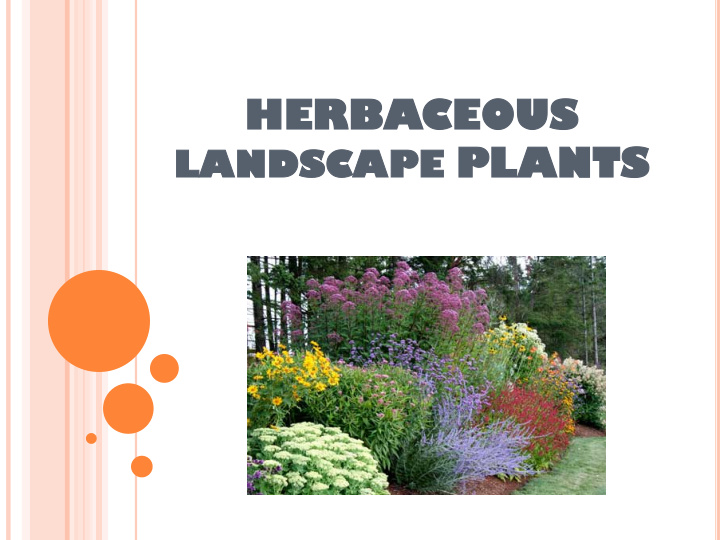



HERBA RBACEOU EOUS NDSCAPE PL PLANTS TS LA LANDS
Kate Patterson A little background (That’s me.)
HERBACEOUS PLANTS IN THE LANDSCAPE • Perennials • Biennials • Annuals • Uses • Species
PERENNIALS Definition Bloom time Life Span
BIENNIALS Biennials march to their own music. Flowering in their second year from seed, they’re too tardy for inclusion with annuals. But because typical biennial plants die after flowering, they lack the year- after-year staying power of perennials.
BIENNIALS
ANNUALS Complete life cycle in one year Long bloom period May reseed or behave as perennials when protected.
Uses for Herbaceous Plants – What do you want it to do? Borders Flowerbeds Containers
Fun Foliage
Flowers
CLIMATE & TEMPERATURE ZONES USDA vs. Sunset
PLANT SELECTION Purpose - Aesthetics: container gardens, curb appeal - Structural: forming flower beds, backdrops - Wildlife: attracting birds, butterflies, bees - Edible: grown for beauty and bounty Requirements - Group together based on light requirements, water, bloom time.
CONTAINER GARDENS Creative container choices Design choices Zone considerations Maintenance
CONTAINER GARDENS
HERB GARDEN HARDY VS. ANNUAL SUB SHRUBS – LAVENDER, ROSEMARY
EDIBLE Form AND Function
CUTTING GARDEN Plant selection
BUTTERFLY GARDEN Attracting Butterflies Water source Flower Choice
BIRD-FRIENDLY GARDEN Water source Plant Choices Hummingbirds, songbirds, etc.
GROUNDCOVERS Stepables Erosion Control Lawn Replacement Texture Weed Control
BULBS Planting Time Bloom Time Storage of tender bulbs – dahlias, glads, cannas Tools
PEONIES Proper pronunciation? Say it how your Grandma used to. Location Transplanting Rootweevils Ant Myth Itohs
NATIVE PLANTS Not always tidy, but effective for wildlife Waterwise Sources : Plants of the Wild in Tekoa, WA Thorn Creek Native Seed in Genessee, ID
MAINTENANCE Dormancy Pinching
MULCHING Timing Options Water What to avoid
WATER “Established Plants” Requirements & Factors Winter Care Mulching Soil Types Stress
FERTILIZING Soil Tests Timing Feeding Soil or Feeding Plants Options - Slow vs. Quick Release
GROOMING Understand how they grow Bloom time/Prune time Grasses
Using what you prune
STAKING Options Benefits
PROBLEMS Disease Insects Deer
Powdery Mildew White or gray powder coating on leaves and buds. Spray or use systemic fungicides, give plants room to breathe.
Slugs, Snails, Earwigs & Friends Destructive leaf chewers. Feed mostly at night. Hand picking, baiting & other tips
APHIDS Soft bodied leaf suckers. Appear on the undersides of leaves, stems and flower buds. Spray, systemic, beneficial insects
Beneficial Insects Lacewings Dragonflies Ladybugs Praying Mantis
Deer Deer Resistant Plants Sprays and repellants
The End “There are two types of gardeners: disciplinarians and referees.” – Bill Hall
Recommend
More recommend